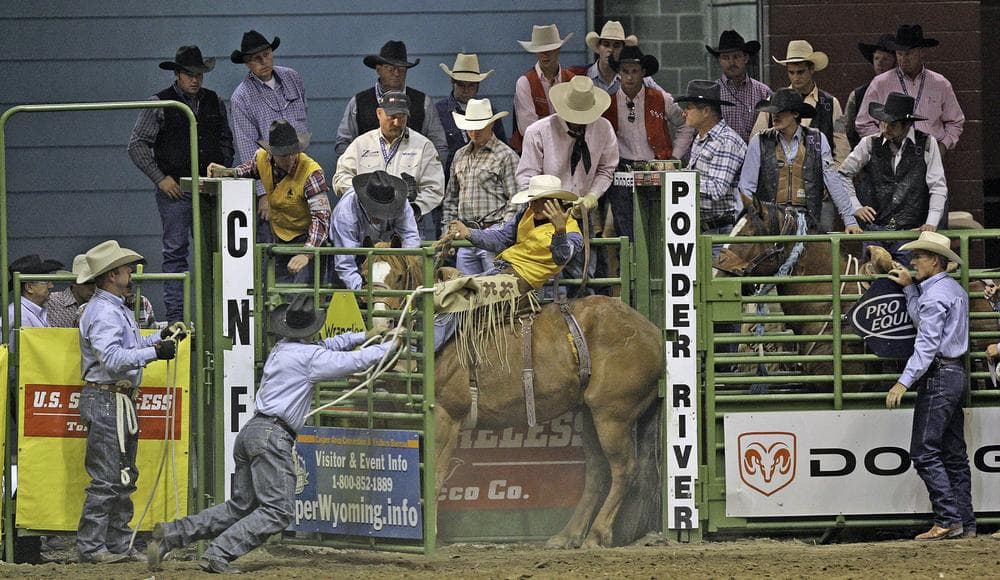Advertisement
In Depth
College Rodeos Round Up Student-Athletes
Resume
The campus of Mesalands Community College near Route 66 in Tucumcari, N.M. would go unnoticed in the landscape were it not for the tall wind turbine belonging to Mesalands’ well-regarded wind energy technology program. Recently, what’s stood out more lately is alive and kicking in the arena a few hundred yards away.
At the far end of a large dirt oval, dozens of college cowboys and cowgirls perched with well-worn jeans and mud-caked boots on the rails of animal pens and starting shoots. They wore leather or silken vests emblazoned with logos of their respective colleges—Cochise College, New Mexico State, the University of Arizona, Dine College.
Almost all the 142 colleges and junior colleges were field teams from west of the Mississippi. Sylvia Mahoney, the author of College Rodeo: From Show to Sport, said these college competitions had been around for more than half a century.
“It was actually officially organized in 1949 by the veterans coming home from World War II, and you see it’s been 62, 63 years now, but it still surprises people that you have college rodeo,” she said.
[sidebar title="U.S. Women Carry On Mexican Riding Tradition" width="630" align="right"]The National Charro Championships in Mexico is a rodeo event that resembles a horseback ballet, ridden sidesaddle at top speed. In September 2012, Bill spoke with rider Sandy Torres and Robin Rosenthal, one of the filmmakers behind the PBS documentary “Escaramuza: Riding From the Heart." [/sidebar]The athletes at this rodeo hosted by Mesalands came from the Grand Canyon region, one of 11 divisions in the National Intercollegiate Rodeo Association. As in gymnastics, they competed not just for team championships, but also for individual titles in events from barrel racing and bareback riding to break away roping and bull riding.
Many rodeo riders receive either full or partial athletic scholarships, and their coaches roam far and wide to recruit high school stars. Mesalands sophomore Macy Fuller said dozens of colleges showed interest in recruiting her, as early as her sophomore year of high school.
“I had colleges from all around the United States trying to outbid each other, trying to pay for everything and paying me money on top of paying for my books, my tuition, my horses, my horses’ feed, stalls,” she said.
Students can be offered cash to enroll—an extra $2,000 a month in Fuller’s case—which is just one reason this college sport is not governed by the NCAA. Riders also earn cash prizes at college events, and can simultaneously compete on the professional circuit. Fuller had already cleared $5,000 in a single weekend. She said the money comes in handy, since all members of the rodeo team bring as many as five of their own horses, feed them, and pay their own entry fees every week for the events in which they compete.
Last year, Fuller was declared college rodeo’s Rookie of the Year and finished second in goat tying at the college nationals. Goat tying, strictly a women’s event, involves galloping at breakneck speed, dismounting on the run, and tying the rear and front feet of the goat waiting at the other side of the oval.
Junior colleges like Mesalands routinely face their four-year counterparts, often with remarkable success. Walla Walla Community College in Washington has won two national men’s titles in the past five years. Texas-based Vernon College, another two-year school, won the men’s championship in 2010.
Mesalands, with barely 1,000 students, has become a wrangler magnet. The rodeo program has grown to 49 students—all on athletic scholarships—from 15 states and three countries. Last year, the women’s team finished fourth at nationals. This year, the men’s team lassoed the country’s top male high school recruit, Mike McGinn.
“In the last five years, we’ve had more academic All-Americans than any other school in the nation,” said head coach C. J. Aragon. “Smart kids learn, whether it’s in the arena or the classroom. When you get kids that are teachable, they’re going to improve in both areas.”
College rodeo commissioner Roger Walters said the alumni of college teams now dominate the professional ranks.
“Each year at Wrangler National Finals Rodeo in Las Vegas, upwards of 90 percent of those top 15 in those events have been in college rodeo. If you want to compare us to baseball, we’re like a farm league.”
Amy Redhorse, the coach of Dine College in Arizona’s largely impoverished Navajo Country, saw rodeo scholarships as an unusual opportunity for the 13 women and men on her team.
“I had to explain to them so many times that it’s important because you probably have more college credits than your parents, and sisters and brothers. You need to advantage of it because it’s getting paid for and you’re doing something that you really love to do.”
The college rodeo schedule runs through the fall and picks up again in the spring. The college national finals take place next June in Casper, Wyo.
This segment aired on October 27, 2012.